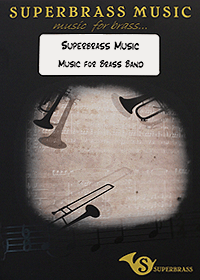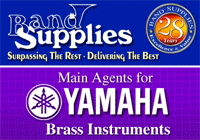London Brass
20-Oct-2004Regent Hall
London
Friday 15th October 2004
When Philip Jones stepped down from public performance, a number of the members of his group, the Philip Jones Brass Ensemble (PJBE), carried on performing, changing their name to "London Brass". Operating as either a quintet or ten-piece group, they have continued seeking out new repertoire, both in terms of compositions and arrangements. On this occasion, they appeared as a quintet consisting of Andy Crowley and Gareth Small, trumpets, Pip Eastop, French horn, Richard Edwards, trombone, and Peter Smith, tuba.
They commenced with an arrangement by Paul Archibald of some of the "Dances of Terpsichore" by Michael Praetorius. Known amongst other things for a number of written treatises on music and instrumentation, no doubt he would have been amazed to see what can now be accomplished by the successors to the natural trumpets and horns that he would have known. With colour being added by the use of various trumpets, including rotary valve instruments, much was made of the contrasting dynamics. Paul Archibald being one of the leading exponents of the piccolo trumpet, it was no surprise to find that instrument featuring prominently, often in answering phrases exchanged by the two players, seated either side of the semicircle.
The five players were all kept busy, each taking the lead at times, with the rotary valve trumpets contributing a mellow toned background to the French horn lead, and the "Chicken Dance" featuring the bright sound of the Eb trumpet. The tuba was featured in a very high-lying solo, leading to some very smooth and controlled playing by the trio of horn, trombone and tuba. In the last section, Richard Edwards demonstrated that anything the valves could do the slide could also do, with some extremely agile work, accompanied by antiphonal trumpets.
The programme listed the "Three Sonatas" by Scarlatti as having been arranged by Stephen Dodgson, but in fact Paul Archibald had been at work here as well, being responsible for the second and third. Arranged from keyboard works, there was more opportunity for answering phrases to be brought out and the counterpoint being highlighted, although their reading incorporated contrasting dynamics that would not have been possible on a harpsichord! The "Andante" featured Pip Eastop on flugel horn, his sound at the bottom of the instrument more breathy than is normally to be found in the brass band world. The playing here was very smooth, with an admirably uniform approach to ornamentation, and the sparing use of vibrato warming the sound. The "Vivace" brought with it some very agile playing and clear articulation throughout with very neat dovetailing of lines between the players.
The only original work for brass in their programme was Malcolm Arnold's "Brass Quintet, Opus 73". Written in 1961 for the New York Brass Quintet, the first movement was described as portraying "the trumpets as otters in the water, and the other three as wise monkeys looking on, and eventually deigning to join in". Featuring some very athletic tuba playing, and secure intonation throughout, the chromatic twists, often led by the trombone, were always convincing, and the unexpected clashes on reflection seemed to be just right. Horn and tuba opened the second movement in octaves, setting out an atmosphere reflecting the bleakness of the Cold War, as the trumpets divided their phrases imperceptivity between themselves. A cadenza-like passage from the trombone cut clearly through the texture, with octave leaps around the ensemble being very secure, before moving to an aura of serenity at the end of the movement. With the finale the atmosphere lightened considerably, as per the score marking "con brio", with striking whoops from the horn and glissandi from the trombone, ending the first half of the concert in an upbeat mood.
There is some doubt amongst scholars regarding the piece known as the "Toccata & Fugue in D minor" by Bach. Now widely held to have originated as a piece for solo violin, with Bach's own contribution being questioned, it nevertheless made for a effective opener for the second half, as arranged by
trombonist Roger Harvey. Incorporating some deft page turning whilst playing one trumpet with another delicately balanced on their laps, the arrangement makes much of the interplay between pairs of instruments. It was definitely a tour de force, both in terms of playing technique and also sheer stamina, with breaths having to be snatched where possible. The tuba part called for particular agility in the bottom part of the range, whilst all parts incorporated long runs of semi-quavers to be integrated into the whole.
Karl Jenkins, the composer responsible for the various "Adiemus" recordings, is from the same village in Wales as trumpeter Gareth Small and his father Tony, who had arranged the two pieces forming "The Adiemus Collection". "Salm O Dewi Sant" ("Hymn to Saint David") featured Pip Eastop once more on flugel, whilst in "Song of the Spirit" the horn took a prominent role, with heroic-sounding phrases, accompanied by unexpected harmonic twists and effective trumpet flourishes, all constantly moving forward with an edgy syncopation.
The final programmed item brought a return to keyboard music, this time by the Spanish composer Albeniz, arranged by London Brass's regular horn player Richard Bissill. In "Prelude" the Spain of the bullfight could be heard, with declamatory phrases starting slowly then building up in both tempo and intensity. A somewhat sleazy "Tango" was kept at a steady pace, with each player being featured in turn before blending back into the ensemble, the gentle tango rhythm underpinning the whole piece.
In "Malaguena" it was hard to believe as the chords built up that there were only five players, with players slipping back in to add another note to the chords in between the individual solo flourishes. Finally, the "Zortzico" brought things to a rousing conclusion - apart, that is, for an encore in the form of Lee Morgan's "Sidewinder". Building up from an outstanding tuba ostinato, flugel and trombone were both featured as solo instruments to put the seal on a fine afternoon's music-making. Despite the absence of a couple of regular players, London Brass had demonstrated conclusively that their reputation in the world of music is richly deserved.
Peter Bale









